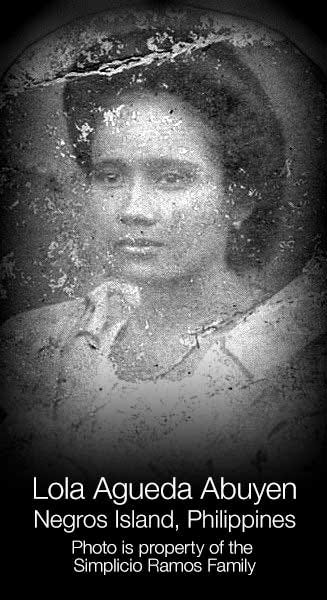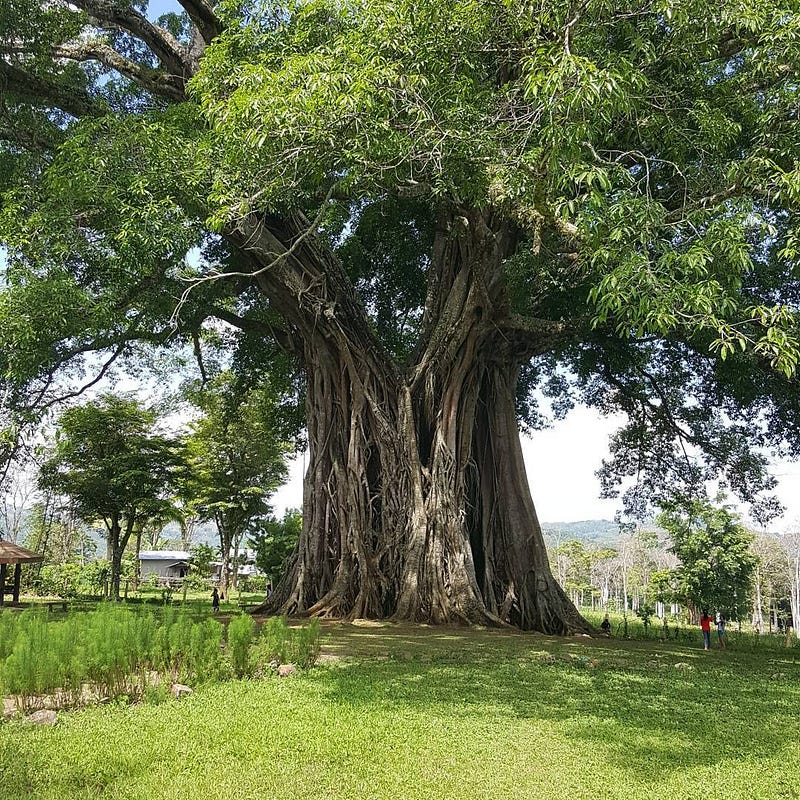The ghosts and land spirits of my ancestral land paid me three visits. I dreamt of the long-gone aeta on the island of Buglas, dancing. I am being told of forgotten things, by diwata—nymphs—that dwell in the land and by restless souls who need remembrance.
You might say I have multi-dimensional experiences.
This has lead to ancestral healing. The land where my ancestors lived needs healing.
Seeing my ancestral roots in her face
When my son Brennan saw the picture of his great, great grandmother, Lola Agueda Abuyen Labayen. He exclaimed “she’s a native!” I was surprised, and proud of his clear sight. I’ve always shunned the description mestiza in myself and preferred to think of myself as native. But my great grandmother truly was a native. In that moment, me, a mestiza, came to see and love Lolo Agueda in her indigenous beauty.

I look into her eyes, through the tatters of this hundred-year-old faded photo… and I knew love for her, although I never met her.
Lola Agueda died at an early age and her two daughters, Lola Tilde and Lola Nene, were sent to boarding school at Assumption, to be raised by french nuns, on the neighboring island of Panay.
I sense the sadness of Lola Agueda’s early death, and the orphaned experience of her daughter, my grandmother Lola Tilde, of being raised not by her own mother but by french Assumcionista nuns.
My great grandmother Lola Agueda is from the mountains of Buglas island. This was a place where the sky kissed the earth and children played with clouds. Lola Clotilde remembers playing catch with the cloud mist that passed through her open home in the mountains.
I imagine her and her sister running around in a home covered by cloud, and surrounded by diwata ng ibabaw, whispy nymphs of the sky.
The land cut off. A people cut off—from their stories of pain.
The island of Buglas got it’s name from the negritos indigenous to the isle. Buglas means cut off. This island was cut off from the larger land mass by the rise of the seas. It’s the negrito ancestors and descendants who honor and remember that time.
When the Spanish came, they named the place Islas de los Negros, island of the blacks. It’s now called Negros Island. On the map it shows up as Negros Occidental and Oriental.
I visited this thousand-year-old tree this past spring.

The tree is significant to me in many ways. As we walked up to the tree my cousin Rushty muttered to himself that “this tree is sacred.”
He and I are the eldest female and male descendants in our branch of the Crispino and Melitona family tree.
My ancestors lived on the island of aetas, negritos, when this tree was young. Well, this ancient tree has outlasted them all.
The tree has witnessed the times when the áte (aeta) people flourished on this land. It has witnessed the coming of the Spanish invaders. And it’s witnessed the influx and domination of ilustrado settlers and their hacienda workers from neighboring islands.
I’ve always wondered how my landowner, settler ancestors got hold of their land.
Today, I found this IG post about the Austrolanesians.
I commented briefly there. And I thoughtfully re-comment and expound here…
When painful truth reveals itself
This is significant to me. One side of my mom’s family came from the mountains of Negros Island… They probably had negrito or ati blood.
I have kalolohanon/kaninunoan that were the indigenous to that island. They were probably, displaced killed, or mixed in with the settles. They have been forgotten.
The spanish colonizers made colonized Filipinos ashamed of their dark skin. So it’s not surprising that no one in my family remembers that far back.
The other side of my mom’s family settled there. I am talking about great, great, great, great grandparents who were Spanish and Chinese mestizo, ilustrado outsiders…
One side of my family is proud to say that their ancestors owned “land as far as the eye could see.” My ancestors were settlers condoned by the Spanish colonizer government.
To be brutally honest, I want to know if how the pushed out the natives who used to dwell and cultivate food on those lands.
This hidden family and island history is unspoken of, and conveniently forgotten by my land-owner ancestors. And all the descendants of the landowners on Negros Island.
They descendants of the landowners mainly go back in history—as far to the time of the glory days of the sugar industry and hacienda owners. I’m still waiting for someone to go back as far as the time of the settlers and the dwindling population of the ati people.
When I say to family, those proud of their landowner predecessors — “ Yes, that’s nice — but how did they get that land? And what happened to the ati people who used to live here?” I get blank stares, or I’m politely ignored. Or they really just. can’t. hear me.
It’s beyond their minds and emotional capacity to comprehend any probable land grabbing, settler-horrors and wickedness in their family tree. Am I making this up? Only the spirits know.
This hidden history hints at why some of my great, grandparents and grand uncles and aunts, were not just snobby, but also stingy and mean-spirited.
Even towards each other. I am still catching these stories from the elders. They don’t realize I’m listening.
Many descendants are so forgetful. Who wants to remember pain and suffering on their land?
My grandmother Lola Tilde was a strong, forgiving woman. Her forgiveness diminished most of the power of trauma that was coming through the family threshold to dwell as karma. Her deep, far-extending generosity comes from a heart that knows joy. And loss. Many people still remember her generosity. Others remember her forgiveness. Depending on what side of the fence they were on.
I’m talking about skeletons in the closet. And I am probably uncovering, with these words, ancestral bones hidden in the land by murderers and land grabbers. Ancestors on both sides of my mom’s family tree.
Ancestral trauma? I’m a descendant of people who were takers and of the one’s taken from… of the invaders and of the invaded upon… of the privileged landowners and of the displaced natives who escaped to the mountains.
What painful stories got buried away in the crypts where my ancestors lie now?
My family knows me as one who accepts and loves unconditionally and can forgive. I am a healer in my family. I listen with no judgement. I seek to know, accept, forgive, reconnect, bring back the sacred and honor and heal the land. And my family.
#decolonization #deprogramming #privilege #mestizo #settlers #descendants #ancestors #sacred #interconnection #healing #forgiveness #kapwa #pakikipagkapwa






Comments are closed.